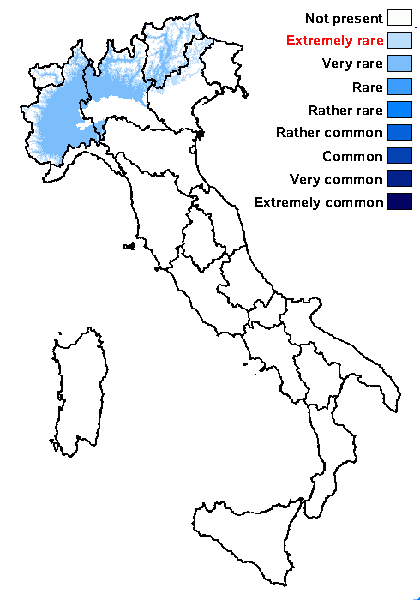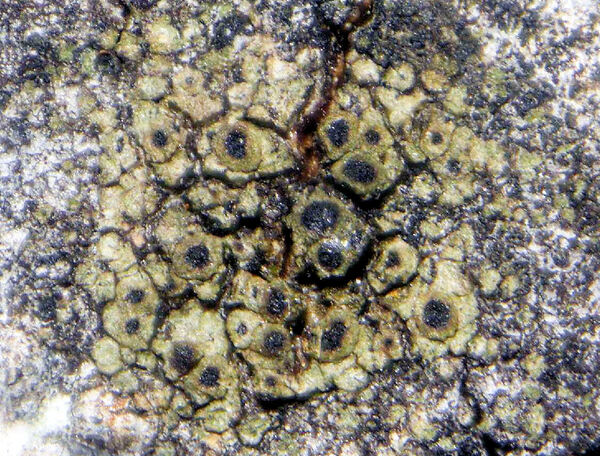Rinodina polyspora Th. Fr.
N. Acta Reg. Soc. Sci. Upsal., ser. 3, 3: 226, 1861.
Synonyms: Berengeria polyspora (Th. Fr.) Trevis.; Buellia polysporella (Nyl.) Arnold; Lecanora polyspora (Th. Fr.) Nyl.; Lecanora sophodes sensu A. Massal. non Lichen sophodes Ach.; Lecidea polysporella Nyl.
Distribution: N - Ven (Trevisan Lichenoth. Ven. 21: Rinaldi 1994), TAA (Massalongo Lich. It. 237: Giralt & Mayrhofer 1994, Nascimbene & al. 2007b), Lomb (Anzi Lich. It. 221: Giralt & Mayrhofer 1994, Arosio & al. 2003, Ravera & al. 2022), Piem (Griselli & al. 2003, Piervittori 2003, Isocrono & al. 2004, Matteucci & al. 2010), VA (Ravera & al. 2021c, Ongaro & al. 2022).
Description: Thallus crustose, episubstratic, thin, discontinuous, smooth, whitish grey to pale grey, sometimes delimited by a dark prothallus. Apothecia lecanorine, usually scattered, broadly attached, 0.2-0.5 mm across, with a flat to convex, reddish brown disc, and a thin, entire, often finally excluded thalline margin. Thalline exciple 50-80 µm wide laterally, corticate, the cortex 15-35 µm thick, I-; proper exciple c. 10 µm wide laterally, slightly expanded to 15-20(-30) µm in upper part; epithecium reddish brown, K-; hymenium colourless, 80-110 µm high; paraphyses 1.2-2 µm thick at mid-level, the apical cells up to 3 µm wide; hypothecium pale yellow, 50-120 µm high. Asci 16-spored, clavate, the K/I+ blue tholus penetrated by a faintly amyloid apical cushion with parallel or diverging flanks, the wall K/I-, surrounded by a K/I+ blue outer layer, Lecanora-type. Ascospores 1-septate, brown, ellipsoid, (11-)13-15(-17) x 6-7.5 µm, with a well-developed torus and a minutely warted wall at maturity, Physcia-type, with ontogeny of type A (apical wall thickening after septum formation). Photobiont chlorococcoid. Spot tests: K-, C-, KC-, P-, UV+ lilac. Chemistry: no lichen substances, except a UV+ lilac unidentified substance at 350 nm before charring.Note: a temperate species found on smooth bark, especially of Fraxinus, Sorbus and Carpinus in open woodlands; probably declining. It was included as “Regionally Extinct” in the Italian red list of epiphytic lichens (Nascimbene & al. 2013c).
Growth form: Crustose
Substrata: bark
Photobiont: green algae other than Trentepohlia
Reproductive strategy: mainly sexual
Commonnes-rarity: (info)
Alpine belt: absent
Subalpine belt: absent
Oromediterranean belt: absent
Montane belt: extremely rare
Submediterranean belt: very rare
Padanian area: absent
Humid submediterranean belt: absent
Humid mediterranean belt: absent
Dry mediterranean belt: absent

Predictive model
Herbarium samples
Growth form: Crustose
Substrata: bark
Photobiont: green algae other than Trentepohlia
Reproductive strategy: mainly sexual
Commonnes-rarity: (info)
Alpine belt: absent
Subalpine belt: absent
Oromediterranean belt: absent
Montane belt: extremely rare
Submediterranean belt: very rare
Padanian area: absent
Humid submediterranean belt: absent
Humid mediterranean belt: absent
Dry mediterranean belt: absent

Predictive model
| Herbarium samples |
 INDEX FUNGORUM
INDEX FUNGORUM
 GBIF
GBIF
 DOLICHENS
DOLICHENS




